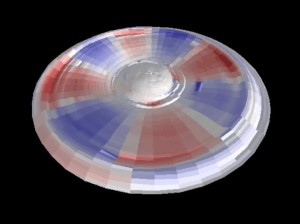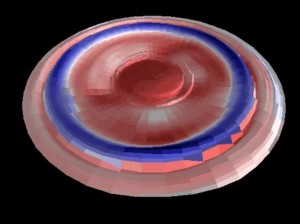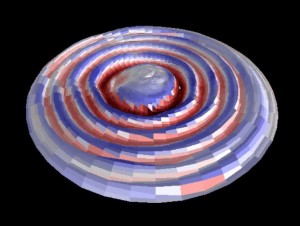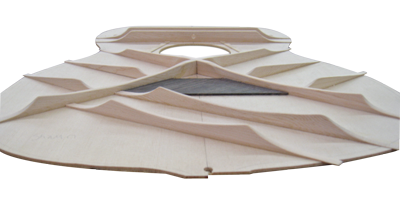Quote:
Originally Posted by Vancebo

What was the story on those A Ref amps? I was never able to see one in person.
|
The A-ref was based on a distributed mode loudspeaker (DML) also named Balanced Mode Radiator (BMR).
Read
https://en.wikipedia.org/wiki/Distri...de_loudspeaker
and
https://www.cambridgeaudio.com/blog/what-is-bmr

The goal is to get rid of the tweeter.
Having the the tweeter away from the woofer creates phase misalignment when the listener is not in front of the loudspeaker. (That's why AER compact 60 has a twin cone speaker for example)
However a standard loudspeaker needs a tweeter to handle high frequencies. At high frequencies, a loudspeaker quits the "pistonic" mode and starts to support many differrents modes. It's called the loudspeaker break-up
Here is a simulation at 500 Hz from nedlab.com

Then at 1500 Hz

Then at 3000 Hz

All thoses high order modes have resonances at different frequencies so the response of a standard speaker at high frequencies has a lots of peaks. That's why we use crossovers, tweeters, horns...
The DML/BMR idea was to structure the loudspeaker cone to actually select one higher order modes against the others.
Here is the response of a HIBM65C20F DML speaker measured and posted on diyaudio forum

The hole between 1kHz and 2KHz is the transition between the pistonic mode and the "selected" higher order mode (the one pictured in the first image for example). Ok it's not flat, but there is not hundreds of peaks.
To say it simply, the speaker has a flat surface and is "braced" like a guitar top.

On the picture above, you can see a cross-sectionnal view of the speaker. "Balancing masses" are indicated in the middle. They act as the bracing of a guitar top.

So basically the A-ref was an amp with a flat speaker that was braced.
I liked so much the idea that I started to build an A-ref / Phil Jones Bass inspired amp. I wanted to use a DSP to control a dozen modes to mimic the beaming of the guitar top (that has more than two modes of course). So I bought many small DML speakers but did not have the time. So they are still in the basement... This is something I should think of because the IR I made for Doug Young is only stereo but the pedal we use has only the 2nd best Sharc processor. With the Sharc processors you have in the Universal Audio devices or Kemper you could probably address 4-8 ouputs and control as many DMLs. That makes 8-16 addressed modes. That would definitely sound closer to a real acoustic guitar...
I hope it answers the question. I've read people thought the amp was not very powerfull and some have reliability issues... Anyway I think the biggest problem is that it was too expansive. Only two or three companies are allowed to make them because of the patent... So LR Baggs had to import them.
If you like the idea, you can also look for
http://www.jmclutherie.ch/en/soundbo...-made-tonewood
it's basically a braced top with surface exciters.
I am suprised that a company like Taylor did not start to sell an amp like that. With all their CNC abilities, it would take them less than a year to put on production an amp that behaves like a guitar. Well they would only need a guy with some DSP abilities but there are plenty of them on the market today.
Anyway A-ref was really a nice move from LR Baggs... But I've never seen any in Europe, I wish I had.
Cuki